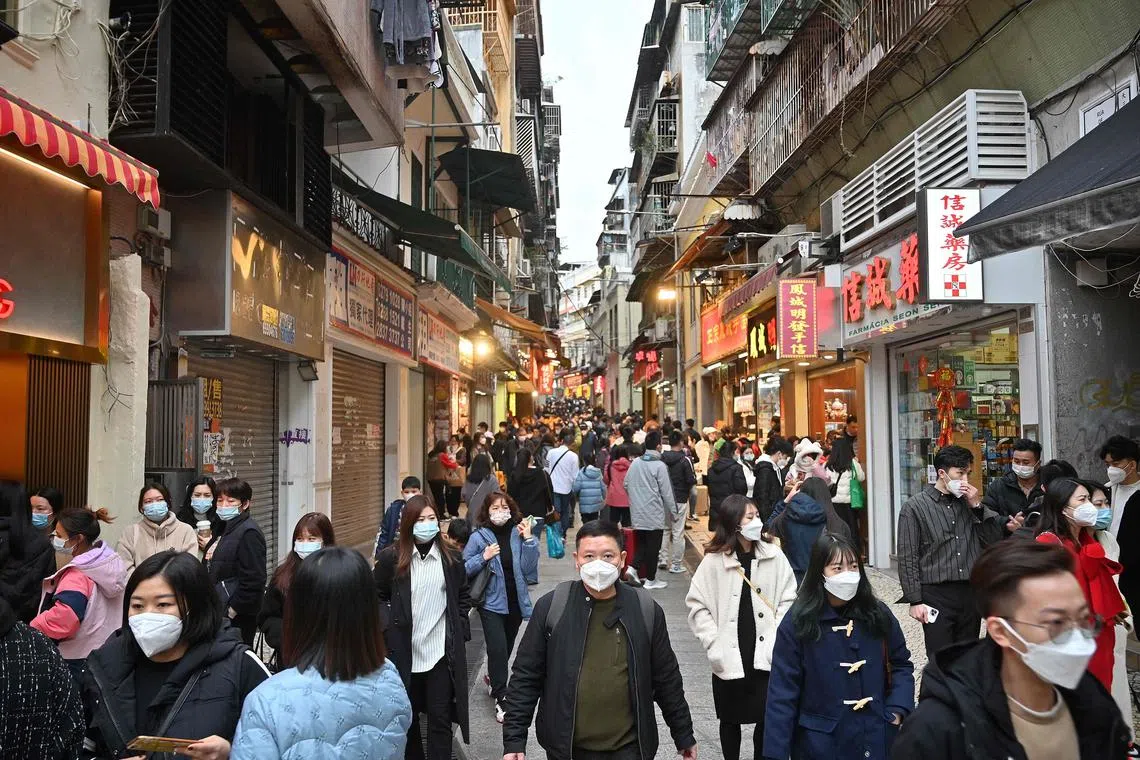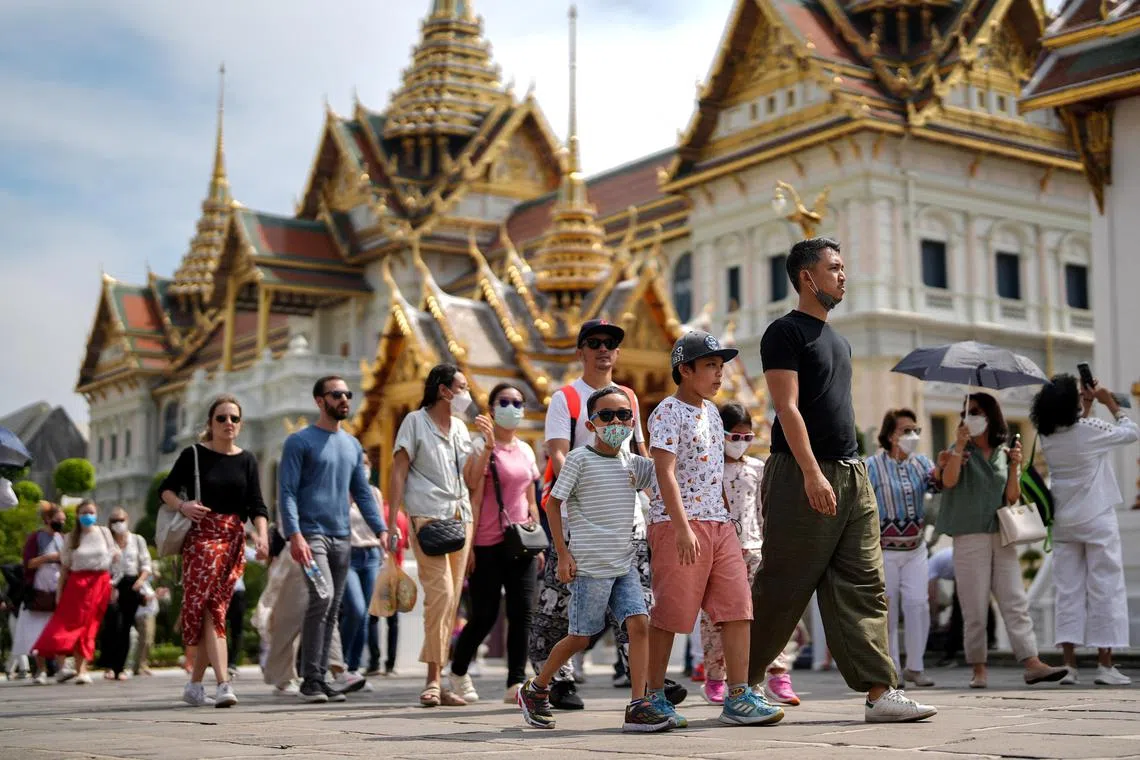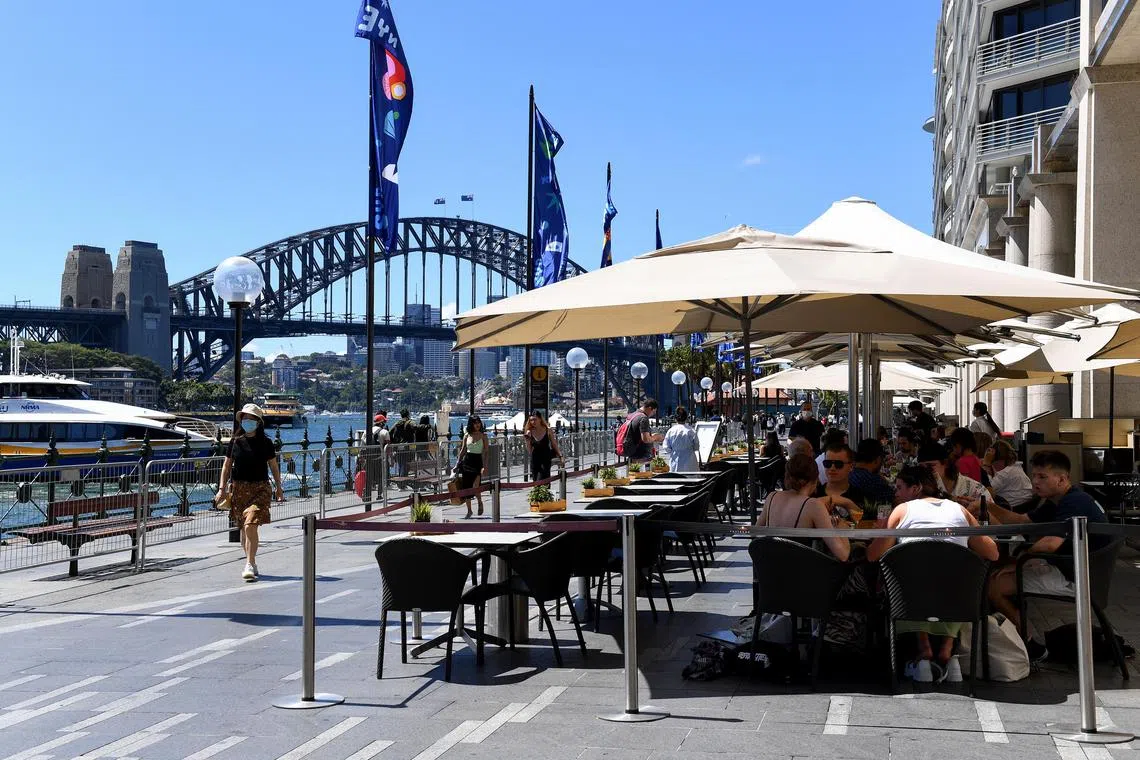Chinese travel is set to return, but the question is ‘when?’
Sign up now: Get ST's newsletters delivered to your inbox

Tourists from mainland China strolling down a street in the southern Chinese enclave of Macau, on Jan 17, 2023.
PHOTO: AFP
Follow topic:
NEW YORK – When the first Chinese tourists landed at Suvarnabhumi Airport in Bangkok in January, they were greeted like celebrities with welcome banners, flowers, gifts, and a scrum of reporters and photographers.
It was the moment that hotels, airlines, tour operators and government officials had long been waiting for – the reopening of China’s borders after nearly three years of pandemic restrictions that effectively cut the world off from Chinese travellers, once the largest source of global tourism revenue.
“It is very exciting to visit warm beautiful places again,” said Ms Hua Liu, 34, a graphic designer from Shanghai, who was among the first visitors to Thailand, where she took a two-week beach holiday as part of a Chinese New Year trip.
“I will make up for the lost time,” she said in a telephone interview.
Her plan: “Stay at nice hotels, book spa treatments, eat at fine restaurants and buy nice gifts for myself and my family.”
Before the Covid-19 pandemic paralysed international travel in 2020, China sent more travellers overseas than any other market, with about 150 million Chinese tourists spending US$277 billion (S$367 billion) abroad in 2018, according to a study by the United Nations World Tourism Organisation and the China Tourism Academy.
That outflow halted in 2020, as countries around the world eased travel restrictions, China maintained an international travel ban for its citizens as part of its zero-Covid policy.
But on Jan 8, the Chinese government opened its borders,
Some in the travel industry were predicting a flood of international Chinese travellers after search interest for outbound flights from China increased by 83 per cent between Dec 26 and Jan 5, with international flight bookings up 59 per cent in the same period, according to Chinese online travel agency Ctrip.
But while there has been a bump in tourism to nearby destinations, including Macau, Hong Kong, Thailand and Singapore, farther destinations are still waiting.
In addition to high levels of Covid-19 cases within China, Chinese travellers face long delays in getting passports and visas, high prices for international flights and a lack of capacity, as many carriers cut flights during China’s long lockdown.
As at Jan 27, the number of airline seats available on direct flights from China to Britain in January was at about 8 per cent of those available in 2019, according to VisitBritain, the official tourist board.
The first direct flight scheduled between China and Switzerland on Jan 26 was cancelled because of a lack of passengers.
Thailand gets ready

A Thai clothing rental vendor assists Chinese tourists to don Thai traditional costumes at the Temple of Dawn in Bangkok, on Jan 23.
PHOTO: EPA-EFE
Before the pandemic, busloads of up to 700 Chinese tourists daily crowded into Maetaeng Elephant Park in the low-slung hills of northern Thailand, about an hour north of Chiang Mai.
Mr Borprit Chailert, the park’s manager, is eagerly awaiting their return, but only about 40 Chinese tourists have shown up, he said.
When they do arrive, renting elephants from nearby villagers to fortify his herd of 76 will not be difficult, he said.
But it is hard to know when to bring on more workers and where to find them, as many left the tourist region and switched jobs when tourism stopped, he said.
“If we want to hire 100 people today, we can’t do that because we’re not sure,” he said. “I don’t know, maybe in the next two months, the Chinese government says, ‘We’re closing the border again.’”
With its economy heavily dependent on tourism, Thailand lost out on tens of billions of dollars in spending by Chinese tourists over the past three years.
The Chiang Mai office of the Tourism Authority estimates that the city, known for its stunning Buddhist temples and heavy dependence on tourism, will welcome back about 600,000 Chinese visitors in 2023 who will spend about US$230 million – about half of the total from 2019.
The real numbers will not start until the second quarter, people in the Thai travel sector say.
Many Chinese tourists traditionally come to Thailand on group tours (they made up about half of the Chinese visitors in Chiang Mai), and the Chinese government allowed tour operators to restart their businesses only on Feb 6, and then only under a pilot programme with about two dozen countries, including Thailand.

Depending heavily on tourism, Thailand lost out on tens of billions of dollars in spending by Chinese tourists over the past three years.
PHOTO: REUTERS
For now, only independent Chinese tourists who can afford the expensive airfares are taking trips.
But not everyone is keen to welcome back group tours.
Even before the pandemic, operators in Thailand and China saw a reversal of the group tour trend and a shift towards more tech-savvy Chinese travellers armed with booking and experience apps taking trips on their own.
Over the past decade, while the overall numbers of Chinese tourists rose, group tours dwindled amid a crackdown on so-called zero-dollar tours in Phuket.
Often illegal operations dodging taxes, these tours typically were controlled by Chinese investors who owned buses, hotels, restaurants, spas and gift shops, siphoning off tourist spending from locals.
They were known for pressuring guests to buy overpriced souvenirs at the shops they controlled.
“I don’t think that we will have more of the big tour groups,” said Ms Nantida Atiset, a hotel owner in Phuket and vice-president of the Phuket Tourist Association. “I think they will come back, of course. It’s just a matter of how big they will come back.”
Pricey flights to London and Australia
In London – another popular destination for Chinese travellers – more than 300,000 people visited Chinatown for the first Chinese New Year parade since the pandemic, but few Chinese tourists were present.
Mr Feng Yang, manager of Shanghai Family, a Chinese restaurant in central London, did not expect travellers from China during the Chinese New Year period, but was hopeful they would return in a few months. “They’re still affected by Covid-19,” he said, adding that his business would most likely not suffer because about 85 per cent of his customers are Chinese students from the surrounding universities, who are staying put for the holiday.
The slow growth can be blamed on a combination of factors.
“There aren’t many flights. They will tend to be more expensive and people will need a visa to come,” said Ms Patricia Yates, chief executive of VisitBritain, adding that the return of the Chinese to Britain would be a “slow build” in 2023, with higher expectations in 2024.
Round-trip flights to London from China cost about US$1,300 and she expects the number of seats on flights from China to Britain to grow to only 30 per cent of 2019’s capacity by June. “That is really necessary to get people on planes,” she said.
Before the pandemic, China was Australia’s biggest visitor market in terms of spending. The country received 1.4 million Chinese visitors in 2019 who spent US$12.4 billion.

An outdoor dining area along Circular Quay in Sydney, New South Wales, Australia.
PHOTO: EPA-EFE
Chinese travellers have started to return to visit friends and family, but travel operators do not expect an influx of leisure travellers for several months, as flights are expensive and Australia is not on China’s approved list for group tour destinations.
Australia also requires Covid-19 testing for Chinese travellers. In January, round-trip flights between China and Australia ranged between US$1,800 and US$3,000.
Before the pandemic, Chinese tourists were known for being willing to spend money, said Mr James Shen, owner of Odyssey Travel in Melbourne.
“Chinese tourists are the ones who say, ‘I don’t want to take a boat. I want to take a helicopter,’” he said. “It might be a 10-minute journey, A$400 (S$367) – very expensive – but Chinese tourists will say, ‘I want to take this, not the boat, because maybe I’ll get seasick.’”
While many travel operators are eager for their return, some worry the industry may not be able to keep up with the tourist influx.
“The industry disappeared for two years. It’ll be very hard for it to recover,” said Mr Rick Liu, owner of TanTan Holiday travel agency in Melbourne. Many drivers and tour guides found other work while the tourism industry was on pause, he added, and hiring them back may be difficult.
“I’m happy that we’ll have more tourists, but I’m also a bit worried about whether we’ll be able to accommodate them properly, provide them with high enough quality service,” he added. “We’re a bit out of practice.” NYTIMES

